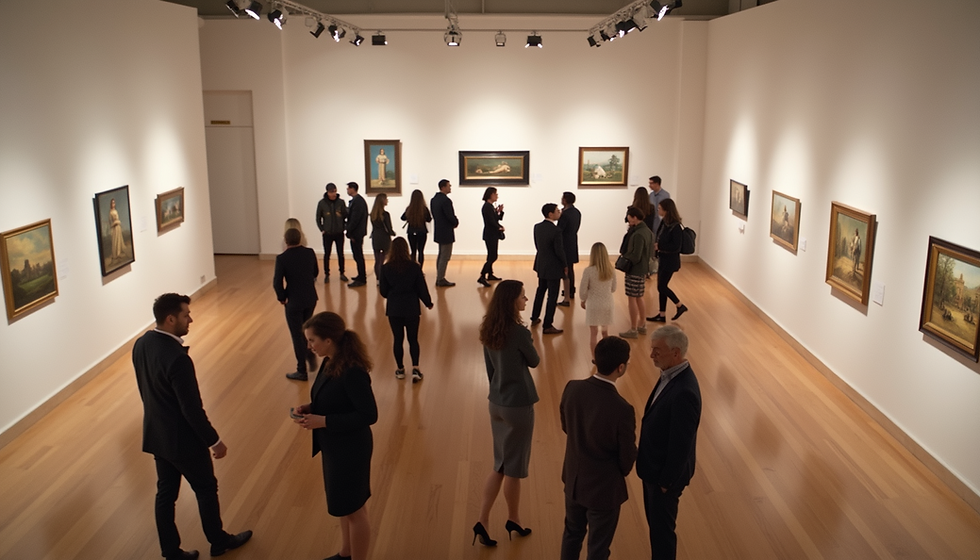Buying Real Painting Art vs NFTs: Which is Superior?
- Doron Akiva
- Oct 13
- 4 min read
In recent years, the art world has experienced a seismic shift with the rise of Non-Fungible Tokens (NFTs). Digital art in the form of NFTs has emerged as a new frontier for collectors while traditional painting art continues to hold its ground as a preferred choice for many. This blog post aims to explore the differences between purchasing physical art and digital art as NFTs, with a strong emphasis on why traditional painting art retains its superiority in many aspects.
The Emotional Connection of Physical Artwork
When you buy a piece of physical art, you aren't just obtaining a decorative item; you're acquiring a unique experience and an emotional connection. The tactile nature of a painting invites viewers to engage with the work on a deeper level. The brush strokes, colors, and textures create a physical presence that digital art often lacks. This richness draws people in, sparking conversations and evoking emotions.

Consider a beloved painting by an artist like Vincent van Gogh. Standing in front of "Starry Night," one can feel the swirling emotions radiating from the canvas. That in-person experience standing there, sinking into the artwork creates memories that a digital screen simply cannot replicate.
The Timelessness of Traditional Art
Physical art has a temporal aspect that is often overlooked. While trends may come and go in the digital world, traditional art remains timeless. A good piece of artwork can endure for generations, resonating with audiences across different cultures and eras. The investment you make in a painting is not just for the moment; it is for the future.
In contrast, the NFT space is characterized by its volatile nature. Art investors have witnessed dramatic price fluctuations on platforms like OpenSea, where enthusiasm can lead to a sharp rise in value, only to fall just as rapidly. Real art, with its historical and cultural significance, offers collectors something more constant a legacy that can be passed down through generations.

For many collectors, investing in traditional art is akin to investing in heirlooms. While NFT ownership could be tokenized and traded, the emotional and financial foundation of a classic painting often provides greater stability and assurance.
The Experiential Value of Exhibitions
Visiting art galleries and exhibitions introduces collectors to the vibrant community surrounding traditional art. Engaging with local artists, attending openings, and exploring shows can enrich one’s understanding of art and culture. These shared experiences foster a sense of belonging within the artistic community.
NFTs, on the other hand, exist in the digital realm. While some platforms may host virtual galleries, the social interaction is often diminished. The thrill of attending an artist's first showing or the satisfaction of discussing a piece with fellow enthusiasts in person cannot be replicated in a metaverse or on a screen.
The Role of Authenticity and Verification
Buying traditional art involves a tangible assurance of authenticity. Established galleries and auction houses often provide provenance (the history of ownership of the artworks), certificates of authenticity, and expert appraisals. This verification creates a sense of trust among buyers.
In contrast, the world of NFTs is fraught with confusion regarding ownership and authenticity. Although blockchain technology offers a layer of security, it is not infallible. For instance, works can be counterfeited, and verification methods vary widely across platforms. The risk of purchasing a fraudulent NFT can deter collectors who are accustomed to the well-defined systems in traditional markets.

Addressing the Tech Savvy Appeal of NFTs
There’s no denying that NFTs come with an air of modernity, attracting a younger demographic eager to explore the digital landscape. Not only can artists receive royalties from future sales, but buyers enjoy direct interactions with creators. This democratization of art ownership represents a significant shift in how art is bought and sold, potentially opening the door to many emerging artists.
However, while the tech-savvy might find excitement in these innovations, traditional collectors often appreciate the artistic techniques and craftsmanship behind physical works. Many artists dedicate years honing their skills before showcasing them in galleries, a testament to their commitment and talent.
Moreover, a lack of physical presence in NFTs leads to a fundamental limitation. Digital art can be replicated endlessly, while a painting is one-of-a-kind (or part of a limited series). This uniqueness enhances the value of physical art in ways that digital art struggles to match.

Why Traditional Art Remains a Preferred Choice
The preference for traditional art over NFTs can be attributed to various factors. The emotional connection, sensory experience, timelessness, and tangible authenticity offered by physical artworks are unmatched. Collectors often savor the idea of surrounding themselves with real pieces art that reflects their personality and taste.
Furthermore, art has historically been a physical representation of culture, identity, and expression. The stories behind each artwork add layers of meaning that can be appreciated by those who lay eyes upon it.
Ultimately, while NFTs offer exciting technological innovations and new forms of expression for artists, they cannot replace the intricate experiences provided by traditional art. As the art world continues to evolve, many collectors will likely prioritize physical paintings and art pieces that allow for a deeper connection to the creators and the stories they convey.
Final Thoughts
As art lovers and collectors weigh the merits of purchasing real paintings versus NFTs, it becomes clear that traditional art retains powerful emotional, experiential, and cultural value. Although the digital landscape offers novelties and innovations, it cannot replicate the depth and timelessness so integral to the art experience.
In embracing traditional art forms, collectors invest in more than mere objects; they engage with history, culture, and human emotion in a way that resonates far beyond the confines of a screen. Whether you are an experienced collector or a newcomer to the art world, consider the profound impact of owning a real piece of art that speaks to you.




Comments